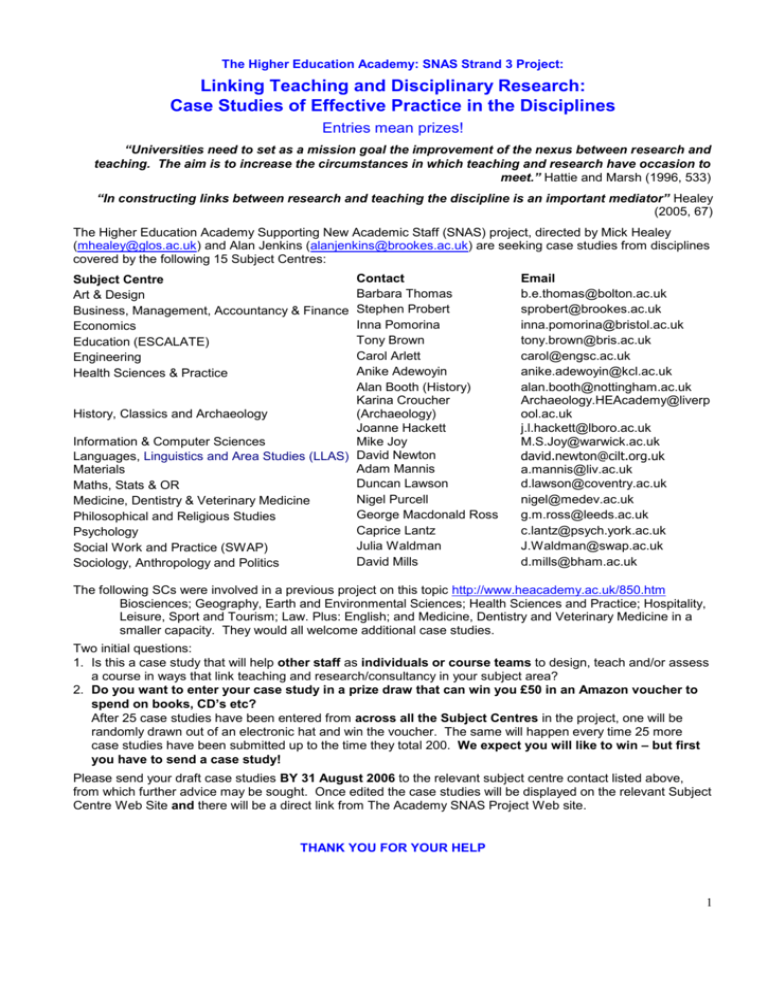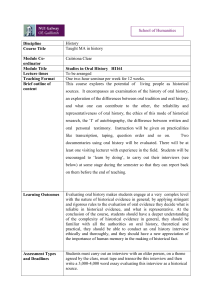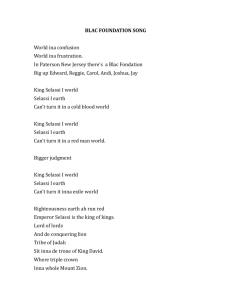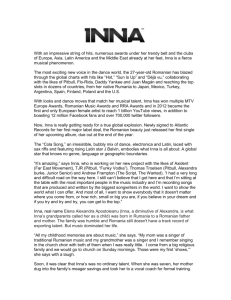Linking Teaching and Research in the Disciplines
advertisement

The Higher Education Academy: SNAS Strand 3 Project: Linking Teaching and Disciplinary Research: Case Studies of Effective Practice in the Disciplines Entries mean prizes! “Universities need to set as a mission goal the improvement of the nexus between research and teaching. The aim is to increase the circumstances in which teaching and research have occasion to meet.” Hattie and Marsh (1996, 533) “In constructing links between research and teaching the discipline is an important mediator” Healey (2005, 67) The Higher Education Academy Supporting New Academic Staff (SNAS) project, directed by Mick Healey (mhealey@glos.ac.uk) and Alan Jenkins (alanjenkins@brookes.ac.uk) are seeking case studies from disciplines covered by the following 15 Subject Centres: Contact Barbara Thomas Stephen Probert Inna Pomorina Tony Brown Carol Arlett Anike Adewoyin Alan Booth (History) Karina Croucher History, Classics and Archaeology (Archaeology) Joanne Hackett Information & Computer Sciences Mike Joy Languages, Linguistics and Area Studies (LLAS) David Newton Adam Mannis Materials Duncan Lawson Maths, Stats & OR Nigel Purcell Medicine, Dentistry & Veterinary Medicine George Macdonald Ross Philosophical and Religious Studies Caprice Lantz Psychology Julia Waldman Social Work and Practice (SWAP) David Mills Sociology, Anthropology and Politics Subject Centre Art & Design Business, Management, Accountancy & Finance Economics Education (ESCALATE) Engineering Health Sciences & Practice Email b.e.thomas@bolton.ac.uk sprobert@brookes.ac.uk inna.pomorina@bristol.ac.uk tony.brown@bris.ac.uk carol@engsc.ac.uk anike.adewoyin@kcl.ac.uk alan.booth@nottingham.ac.uk Archaeology.HEAcademy@liverp ool.ac.uk j.l.hackett@lboro.ac.uk M.S.Joy@warwick.ac.uk david.newton@cilt.org.uk a.mannis@liv.ac.uk d.lawson@coventry.ac.uk nigel@medev.ac.uk g.m.ross@leeds.ac.uk c.lantz@psych.york.ac.uk J.Waldman@swap.ac.uk d.mills@bham.ac.uk The following SCs were involved in a previous project on this topic http://www.heacademy.ac.uk/850.htm Biosciences; Geography, Earth and Environmental Sciences; Health Sciences and Practice; Hospitality, Leisure, Sport and Tourism; Law. Plus: English; and Medicine, Dentistry and Veterinary Medicine in a smaller capacity. They would all welcome additional case studies. Two initial questions: 1. Is this a case study that will help other staff as individuals or course teams to design, teach and/or assess a course in ways that link teaching and research/consultancy in your subject area? 2. Do you want to enter your case study in a prize draw that can win you £50 in an Amazon voucher to spend on books, CD’s etc? After 25 case studies have been entered from across all the Subject Centres in the project, one will be randomly drawn out of an electronic hat and win the voucher. The same will happen every time 25 more case studies have been submitted up to the time they total 200. We expect you will like to win – but first you have to send a case study! Please send your draft case studies BY 31 August 2006 to the relevant subject centre contact listed above, from which further advice may be sought. Once edited the case studies will be displayed on the relevant Subject Centre Web Site and there will be a direct link from The Academy SNAS Project Web site. THANK YOU FOR YOUR HELP 1 The following template is a generic one which you should use if you find it helpful Linking Teaching with Disciplinary Research Case studies for Courses and Course teams See some brief case studies in Appendix 1 First consider this: While our understanding of how to link teaching and research/consultancy is still developing, we think this ‘classification’ will help you describe your practice to others: 1. Developing student appreciation of research/consultancy in the discipline. 2. Development of student research/consultancy skills (explicitly, in addition to other disciplinary and generic skills). 3. Using teaching and learning processes, which simulate research, processes (e.g. project-based modules, dissertation modules, inquiry-based learning etc). 4. Using assignments which involve elements of research processes (e.g. literature reviews, bidding for grants, drafting bids or project outlines, analysing existing project data, presenting at a ‘conference’). 5. Giving students first hand experience of research based consultancy (whether commercial or pro-bono) (e.g. as an ‘intern’, as work-based learning, as a consultant assistant, or as a laboratory assistant). 6. Bringing data/findings from staff research/consultancy into the curriculum. While we hope you may want to complete all sections in the pro-forma, we only ‘require’ you to complete sections 1 to 5 below: and then you are automatically included in the prize draw for a £50 voucher (but we hope you will also complete the rest!). Note: It is section 5 that is most important and for entry to the prize draw needs to be a minimum of 500 words. 1. Title of case study: (such that it conveys to others the central aspects) 2. Contact details Name and address: Tel: Fax: Email: 3. Classification Category: (Please choose one or more of the classifications above which best reflects your example – e.g. develop student appreciation) 4. Context: Course/unit/module title: Course title: Level: 2 5. What does the teacher do? (e.g. content, teaching and learning methods, assessment etc). Please ensure this section is written such that staff elsewhere can take the central elements from your practice. Write it like a ‘good’ cook book!). There is no word limit to this section. But for entry to the prize draw this section needs to be a minimum of 500 words. 6. Hot tips and things to look out for: (What is the key advice you would give someone who has decided to adapt this method?) 7. Does it work? (Student, employer, peer review/response/reaction? What does evaluation and /or research reveal as to its impact?) 8. What problems/issues have arisen? 9. Details of support material/course work/assessment methods (perhaps attach as a separate file any details that you think would help others; e.g. the detailed instructions you give students) 10. Relevant references (to published articles / web sites by you or others that describe this method) Appendix 1: Selected brief examples of teaching and disciplinary research links 3 Asking questions in plant biology at Australian National University A practical exercise designed for a Level 2 course involves students: making observations in a botanical garden; coming up with 10 questions each (e.g. why do eucalypt leaves dangle?); sharing one of these questions with a group of other students; coming up as a group with hypotheses based on the question (e.g. Eucalypt trees in arid environments have leaves that dangle at steeper angles than those in wet environments); thinking of ways of testing the hypothesis(es); and writing up individually their 10 questions and one hypothesis as a 750 word mini-proposal for a research project. Source: http://www.anu.edu.au/CEDAM/ilearn/inquiry/posing_questions.pdf Geography students at University College London interview staff about their research All year one students to do an assignment in term one, in which students interview a member of staff about their research. Each first year tutorial group is allocated a member of staff who is not their tutor. Tutorial groups are given by that member of staff three pieces of writing which are representative of their work, their CV and arrange a date for the interview. Before the interview students read these materials and develop an interview schedule. On the basis of their reading and the interview, each student individually writes a 1,500 word report on a) the objectives of the interviewee's research; b) how that research relates to their earlier studies c) how the interviewee's research relates to his or her teaching, other interests and geography as a whole (emphasis added). Source: Dwyer (2001) History students in British Columbia contribute research findings to a Web site In 2002, John Lutz implemented History 481: Micro History and the Internet, a learner-centred and research-oriented course in which the main activity was primary archival research on various aspects of life in Victoria, British Columbia from 1843 to 1900. Students worked in small groups to conduct the research and eventually to publish their findings on the website called “Victoria’s Victoria”. John reports that "The feedback I get often says, that if they remember only one course from university, this (course) will be it ... some alumni contact me to say that the web skills have landed them a job.” John notes that the grades in Micro History 481 were approximately 8% higher that the grades that these same students received in other senior history courses that they take from him. Sources: http://web.uvic.ca/terc/newletter/documents/sept_03_newsletter.pdf http://web.uvic.ca/vv/ Introducing enquiry-based teaching methods in literary studies The traditional form of Literary Studies teaching in HE is tutor-centred. In this case study a group of second year students studying Eighteenth Century Literature are introduced to enquiry-based learning in the first week of the first semester. For example, in week 1 the students were given a poem by Samuel Johnson, ‘On the death of Dr Robert Levet’. The poem was issued to students without annotations or supporting detailed biographical information. Each sub-group were asked to address two questions: ‘What kind of language does the poem use?’ and ‘What belief system, if any, does the poem imply?’. Most groups responded to this task actively by exploring and considering the possibilities from a range of perspectives, establishing and pooling any existing knowledge base and assessing its applicability to the task in hand. By emphasising the need to seek other sources to contextualise their answers the facilitator began to establish the research element crucial to moving from ‘problem solving’ to something more active. Source: Hutchings, W. and O’Rourke, K. (2003) 4








